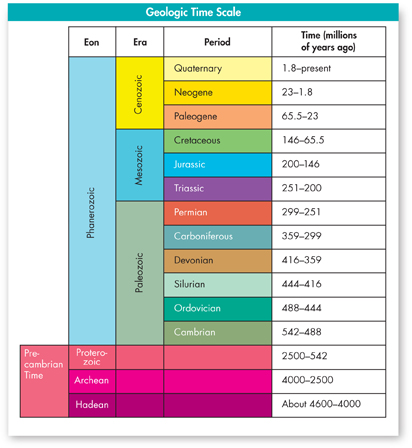Geologic Time Scale
 How was the geologic time scale established, and what are its major divisions?
How was the geologic time scale established, and what are its major divisions?
Geologists and paleontologists have built a time line of Earth's history called the geologic time scale. The most recent version is shown in Figure 19–5.  The geologic time scale is based on both relative and absolute dating. The major divisions of the geologic time scale are eons, eras, and periods.
The geologic time scale is based on both relative and absolute dating. The major divisions of the geologic time scale are eons, eras, and periods.
Establishing the Time Scale By studying rock layers and index fossils, early paleontologists placed Earth's rocks and fossils in order according to their relative age. As they worked, they noticed major changes in the fossil record at boundaries between certain rock layers. Geologists used these boundaries to determine where one division of geologic time ended and the next began. Years later, radiometric dating techniques were used to assign specific ages to the various rock layers. This time scale is constantly being tested, verified, and adjusted.

FIGURE 19–5 Geologic Time Scale The basic divisions of the geologic time scale are eons, eras, and periods. Precambrian time was the name originally given to all of Earth's history before the Phanerozoic Eon. Note that the Paleogene and Neogene are sometimes called the Tertiary period. However, this term is generally considered outdated.
dTable of Contents
- Formulas and Equations
- Applying Formulas and Equations
- Mean, Median, and Mode
- Estimation
- Using Measurements in Calculations
- Effects of Measurement Errors
- Accuracy
- Precision
- Comparing Accuracy and Precision
- Significant Figures
- Calculating With Significant Figures
- Scientific Notation
- Calculating With Scientific Notation
- Dimensional Analysis
- Applying Dimensional Analysis




